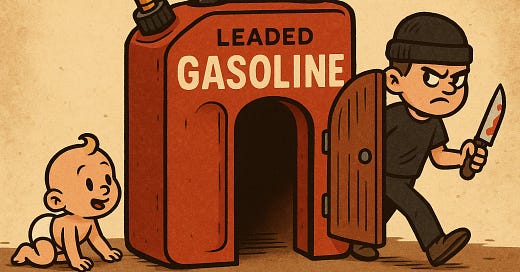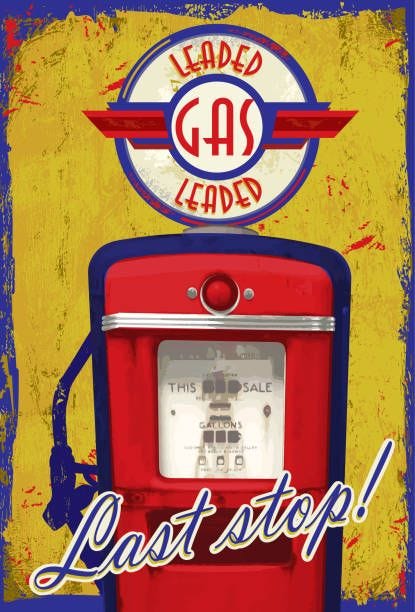Picture America as its most violent. Cities besieged by crime; neighborhoods where children hid indoors. A generation of violent young men.
Now imagine that the culprit wasn't poverty, wasn't broken families, wasn't the usual suspects of social decay. The true mastermind was invisible, odorless, and pouring from every passing tailpipe. A microscopic saboteur that rewired developing brains, transforming future citizens into unwitting participants in a grand, tragic experiment.
For seventy years, this silent predator drifted through American streets, settling into lungs, slipping past the body's defenses, and infiltrating the developing mind. It didn't discriminate between rich and poor, urban and rural, hopeful and desperate. It simply waited, patiently, for its victims to reach the age when damaged neural circuits would translate into damaged choices.
This is the story of leaded gas.
The Silver Bullet
In the winter of 1921, in a laboratory tucked away in Dayton, Ohio, Thomas Midgley Jr., was wrestling with a mechanical demon. Engine knocking.
Congrats! You’ve saved up $300, and rolled a brand new Ford Model T off the lot (That’s only $5k in today’s money…things were cheap back then). But, as you speed up, you hear a gentle tick-tick-tick. This escalates to a CLANK-BANG-RATTLE, as fuel ignites at the wrong moment, creating shock waves that slam pistons against cylinder walls, and setting the next batch of fuel off early too. It's a mechanical heart arrhythmia, tearing the engine apart from within.
GM chemists poured a teaspoonful of tetraethyl lead into a spasming motor. The engine's violent shuddering ceased almost instantly. You see, tetraethyl lead converts to lead oxide in the piston, raising the self-ignition point of gasoline, and stopping the premature ignition that causes knocking.
Lead, as you may know, isn’t great for humans either. Especially the tetraethyl lead GM was playing with. It’s volatile and can be inhaled. It’s lipid soluble and rapidly absorbed through the skin. It was well known to be highly toxic. The inventor, Midgley himself and three co-workers suffered digestive problems, subnormal body temperature, and reduced blood pressure during the latter part of 1922. Midgley went to Florida in 1923 to recuperate.
That, unfortunately, couldn’t stop the relentless march of progress. GM decided to fund a couple tests. Various animals shoved into a room with an engine burning Ethyl gasoline. In a report issued in October 1924 the Bureau of Mines concluded that the danger to the public of breathing lead in exhaust was negligible.
By the mid 1920s, "leaded gasoline" was everywhere. Engines across America were purring. The automotive industry had found its silver bullet—quite literally. Adding lead gave gasoline a distinctive silver sheen.
The Invisible Epidemic
Lead additives were manufactured in DuPont plants, where workers began dropping like flies. Midgley, in a 1925 article “Tetraethyl Lead Poison Hazards” wrote “the actual hazard involved in the general program of treating gasolin with tetraethyl lead has been found to exist only in the manufacturing and handling of the concentrated material.” Midgley said there is no health hazard once lead is mixed into gasoline, provided that it is not misused; nor, he claimed, was there any evidence that the exhaust of a motor using leaded gasoline as fuel was dangerous.
There was a pause on sales as some studies were done. GM quickly brought on some execs who were quite savvy in law and governance. By 1926, after a 1 year hiatus, leaded gasoline was back on the market.
Through the 1940s, 1950s, and 1960s, America's highways filled with vehicles burning leaded gasoline. The lead content of gasoline rose steadily from the 1940s until about 1970, creating an invisible epidemic that would take decades to fully understand.
During these decades, something else was happening across America: crime rates were beginning a steady climb. Violent crime, property crime, juvenile delinquency—all seemed to be increasing, for no real reason at all. Politicians blamed migrants, communists, and other “undesirable elements” for inciting a crime wave. No, I’m afraid this was a home-grown disaster; about as American as you can get.
The Chemical Saboteur
Inside the human brain, lead operates like a microscopic saboteur. It mimics calcium being pumped into neurons in the CNS. It’s similar enough to calcium to bind to receptors looking for it; tricking neurons into believing it has enough of the element, thereby closing the calcium channels, and starving itself of the element. At high concentrations of lead, neurons will not get much calcium at all, and simply die. Humans see that as comas, seizures, and neural degradation.
However, at lower concentrations, say, obtained from environmental poisoning, neurons simply ration the calcium they do have. In kids, one thing that goes is brain-derived neurotrophic factor (BDNF). The brain requires calcium to produce BDNF, which helps stimulate the growth and differentiation of neurons—including those that are key to the development of memory, learning, and cognition.
Kids who breathed lead grew up dumber. The prefrontal cortex, that essential region responsible for executive function and moral reasoning, didn’t get to develop. Impulse control erodes. Aggression increases. The capacity for empathy diminishes.
By the 1960s and 1970s, the children who had grown up breathing automotive lead were entering their teens and twenties—the peak years for criminal behavior. America was witnessing an unprecedented surge in violent crime, and while politicians and sociologists debated causes ranging from urbanization to social decay, the real culprit continued to pour from millions of tailpipes every day.
Fifty years too late.
After 1970, lead content in gasoline fell quickly, reaching approximately zero by the end of the 1980s. The phase-out began not because of crime concerns—the connection hadn't yet been established—but due to mounting evidence of lead's effects on children's development and the need to protect our new fancy catalytic converters.
Then, something remarkable happened. Beginning in the 1990s, crime rates across America began to plummet. The violent crime that had plagued cities for decades started to recede. Property crimes fell. The great American crime wave that had defined the latter half of the 20th century was ending as mysteriously as it had begun.
It would take years before scientists began to piece together the connection. Then, study after study began to come out.
Lead exposure explained 7-28% of the fall in homicide in the US. The correlation held across different cities, different time periods, different demographics. The lag time was consistent—approximately 20 years between peak lead exposure in early childhood and peak criminal behavior in young adulthood.
Leaded gas stole a collective 824 million IQ points from Americans, about 3 points per person.
The lead-crime hypothesis wasn't limited to America. As researchers examined international patterns, they found the same correlation repeating across different countries and cultures. Nations that had introduced leaded gasoline saw crime rates rise roughly 20 years later. Countries that banned leaded fuel experienced corresponding drops in crime after the same lag period.
In 2021 (yes, less than FIVE years ago, and about a hundred years after leaded gas was invented) We’ve finally phased it out. Algeria was the holdout. The United Nations estimates that the global phaseout of the toxic fuel has saved $2.44 trillion per year, and prevented more than 1.2 million premature deaths. Leaded gas is almost gone, notably still present in things like jet fuel (so maybe something to those contrails after all, huh?).
The final toll? Impossible to say. At the very least, we’ve lost a generation of economic productivity, of intelligence, and of peace.
P.S. the guy who invented leaded gasoline? Thomas Midgley Jr? He also invented chloroflorocarbons. He was found strangled, by a device he had made, to help him get out of bed unassisted. It was eventually ruled a suicide.







